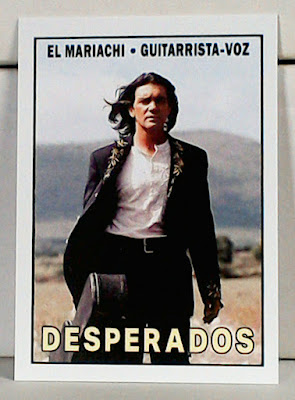Even as a young collector in 1990, I was kind of a traditionalist. I'd mainly collected Topps cards throughout my short existence to that point, and I enjoyed the brand over others like Donruss, Fleer, and Score, right down to the type of cardboard that Topps had always used.
So, the thing I remember most when I opened those first packs of Upper Deck cards (baseball in 1989 and then hockey in 1990-91) was feeling unimpressed. And a bit critical.
"The cards feel flimsy", I can almost hear my young self exclaim.
"There's a hologram on the back, big whoop", I might have also muttered.
Well, I must have gotten over that initial reaction, because I opened a whole bunch of hockey packs that year and came pretty close to completing the set. And I'm sure soon enough I began to appreciate the other aspects of Upper Deck's first try at hockey. After all, the extra full-length photo on the back of each card was cool.
And the photography on the front?

The company seemed to understand that hockey was a dynamic, action-packed sport. "Go nuts", they must have told their photographers.
Granted, there are still headshots. (These guys don't look too happy about that.)
And some "standing around during warmups" shots.
And face-off shots. (Two Miracle on Ice teammates are squaring off in that middle card, look.)
But even those seem to be better than standard. Besides, in a set of 550 cards (400 in the low number series and 150 in the high numbers), you need some of those.
So let's get back to the gems.
Quite a few cards capture the battle for position and fight for every inch of space that's an integral part of the game of hockey.
And Upper Deck managed to sneak some rough stuff into the set, with a bloodied Basil McRae yapping at an opponent across the penalty boxes, and Bob Probert sporting some wounds from a recent battle. Even goalie Rick Tabaracci got into the action!
There are also some great goal celebrations
As well as some interesting camera angles.
Another thing Upper Deck seemed to realize about hockey right from the start is that goalies were separate-but-cool creatures who needed to be captured in their element.
As was fitting for the time, this set also contains numerous subsets.
There were the All-Stars.
And the Award Winners. (Because who didn't want a few extra cards of superstars in tuxedos, I guess?)
There was also a nice "Heroes" subset, featuring legends of the game who'd participated in the all-star festivities that season.
Then there were the rookies.
First, Upper Deck decided to set some of the new guys apart with a "Star Rookie" label. They received a special logo on the bottom right in place of a team logo, along with a little blurb on the card backs.
Next, to show they were really cashing in on the rookie craze, Upper Deck created a separate "All-Rookie Team" subset, with yet another special logo at the bottom right and an even longer write-up on the card backs. There were only six players in this subset: three forwards, two defensemen, and one goalie.
Oh, and don't forget the First-Round Draft Pick cards. The top ten picks were included here.
Then there was a subset commemorating the Canadian National Junior Team, which took the gold medal at the 1991 World Junior Championships.
And perhaps most recognizable, even to modern collectors, the Young Guns.
I'd forgotten that Young Guns were a thing from the very beginning! It's pretty cool that Upper Deck is still running the subset to this day (although they took a few years off here and there). Even more impressive is just how popular the feature has become.
Aside from the studs shown above, the 1990-91 Upper Deck set has a stellar rookie class. Look here:
Along with those three, you've got Alexander Mogilny, Ed Belfour, Jeremy Roenick, Mark Recchi, Mats Sundin, Scott Niedermayer, and Peter Bondra, to name a few.
Oh, and don't forget the team checklists, which contained some pretty impressive artwork on the front.
By now you can see that there were many, many great cards in the 1990-91 Upper Deck set. Just imagine being a kid back then, opening a pack, and finding some of the beauties above in your hands.
But wait, there's more!
The full-length images on the card backs weren't just a novelty, meant to take up space or set a trend. Some great photography can be found there, as well.
Just like on the card fronts, there were goal celebrations.
Upper Deck sneaked in some rough stuff on the backs, too.
But they also made sure to let us know that the referees would be there to break it up.

The horizontal images were great for capturing hockey action.
And more excellent goalie photos.
And finally, here's a victorious, happy team partaking in a high-five, plus a card front featuring Mr. Frank J. Zamboni.
It's hard to believe 30 years have gone by since Upper Deck jumped into hockey. But taking a look back at it now—having finally completed the entire set of low and high numbers—has been a lot of fun. Maybe I'll buy a couple of foil-wrapped packs and open them to recreate the full experience.
Do any of you hockey collectors have memories of this set and the buzz it generated back in 1990?
Share in the comment section, and thanks for reading!







































